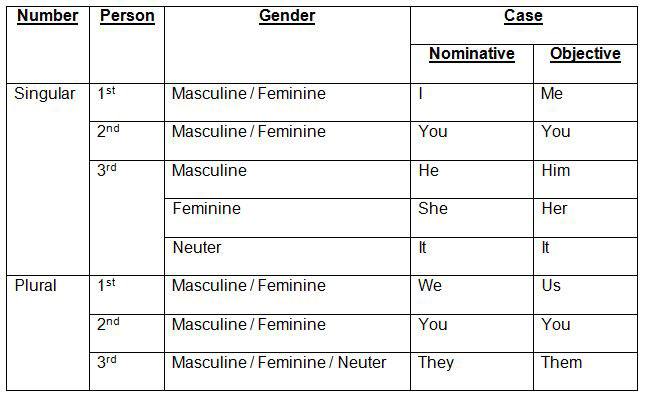What is a personal pronoun? First of all pronouns are words that take the place of nouns. Therefore, pronouns that refer to persons are called personal pronouns. For example: David is now twelve years old and he will attend middle school at the beginning of next year.

What is a personal pronoun?
Personal pronouns take the place of nouns and they have the unique characteristics of gender, person, number and case.
- Gender classifies pronouns as masculine, feminine, and neuter.
- Persons identify the speaker.
- Number refers to singular or plural.
- Case shows the way a pronoun functions in a sentence.
See the chart below for personal pronouns with number, person, gender and case. On this web page, I will only discuss nominative and objective case. I will discuss possessive case on the web page possessive pronouns.

1. Personal Pronouns have person, which indicates the speaker.
- First person personal pronouns indicate the person speaking
- Second person personal pronouns indicate the person spoken to.
- Third person personal pronouns indicate the person spoken about.
Example: I will attend the conference over the weekend.
Example: You will attend the conference over the weekend.
Example: He will attend the conference over the weekend.
Example: They will attend the conference over the weekend.
2. Personal pronouns have number, which indicates how many.
- Singular personal pronouns indicate only one.
- Plural personal pronouns indicate two or more.
Example: He is the best footballer in the club.
Example: She is liked by her fellowship students.
Example: It is the best way to weed the garden.
Example: We went to the shopping centre on Tuesday.
Example: You are the best singers in the group.
Example: They were designated new seats on the airplane.
3. Personal pronouns have gender, which indicates person or non-person.
- Masculine personal pronouns indicate male.
- Feminine personal pronouns indicate female.
- Neuter personal pronouns indicate non-person.
Example: He jumped the fence with ease.
Example: She loved her new car.
Example: It is cold tonight.
Note: There are some exceptions when it comes to gender personal pronouns.
- Sometimes animals are referred to as he/him or she/her.
- Sometimes ships (vessels or vehicles) are referred to as she/her.
Example: The dog is so cute and he is my best friend.
Example: Our cat is very friendly and she loves cuddles.
Example: The Titanic sank in 1912 and she was on her maiden voyage.
Example: The car is new and she is a beauty.
4. Personal pronouns have case, which indicates its function in sentences.
- Nominative case personal pronouns indicate subject or predicate nominative.
- Objective case personal pronouns indicate direct object, indirect object or object of preposition.
Example: She gave her money to the homeless person. (Subject)
Example: This is he who won the award. (Predicate nominative)
Example: Rebekah loved him with all her heart. (Direct object)
Example: She gave me the money for the tickets. (Indirect object)
Example: She gave the money to me for the tickets. (Object of preposition)
Note: I will discuss the possessive case of personal pronouns on the web page possessive pronouns.
Note: I have written an article that outlines the 8 Types of Pronouns With Examples. These must-know pronouns will unlock the power of your writing and speaking gifts.
5. Resources For What is a Personal Pronoun
English Grammar in Use by Raymond Murphy
Plain English Handbook by J. Martyn Walsh and Anna Kathleen Walsh
The Only Grammar Book by Susan Thurman
Mastering English Grammar by S.H. Burton
Connect with us on PINTEREST.





